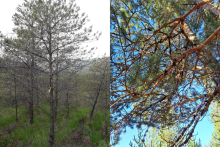Understanding a new health threat to Caledonian Scots pine (Pinus sylvestris)

This project was initiated in response to a new health threat to Scots pine manifesting itself in the form of multiple blackened cankers and dieback of shoots and branches, particularly in the lower crown. Scots pine is regarded as iconic in Scotland for a range of ecological, cultural and economic reasons. Therefore, it is a research priority to gain an understanding of the extent and causes of the canker disease for better protection of this species in the future.
This study identified the primary agents responsible for the symptoms of cankering and crown dieback on Scots pine across Scotland as a previously obscure fungus called Curreya pithyophila which associates with the Scots pine woolly adelgid, Pineus pini. It is P. pini which directly damages the tree through feeding, with feeding sites subsequently colonised by the wound pathogen Crumenulopsis sororia, which in turn causes the blackened cankers that are so disfiguring on Scots pine. Management recommendations based on the current understanding should focus on the planting of 100% healthy and locally adapted stock on sites deemed suitable for Scots pine.
Images courtesy of Sarah Green, Forest Research©
